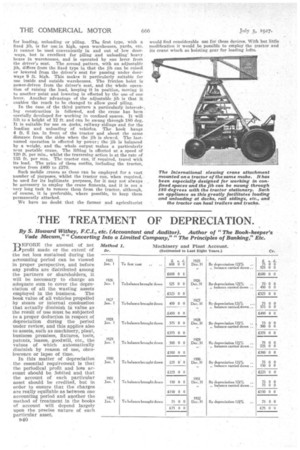PETROL TRACTORS AS MOBILE CRANES.
Page 93

Page 94

If you've noticed an error in this article please click here to report it so we can fix it.
Particulars of Some Interesting Fitments for the International Tractor.
rpUE powerful, but compact petrol tractor may, be said to be coming into its own as a machine which can be used With economy and success for certain classes of goods haulage by road, but apart from mere haulage the tractor is daveloping in other directions, ' and, as will be seen from the illustrations which accompany this article, it can, by the provision of carefully designed fitments, be transformed into a most satisfactory and practicable mobile crane.
The actual tractor we illustrate is the McCormickDeering, marketed by The International Harvester Co. of Great Britain, Ltd., 259, City Road, London E.0.1. This machine has already been described in detail in the columns of Tao Commercial Motar.
Three Types of Crane.
The three main types of crane built as attachments for this tractor are (i) a fixed-jib crane which is built in various heights up to 16 ft. below the hook, the lifting capacity being 15 cwt.; (2) a Iuffing-jib crane which is built up to 16 ft. below the hook and with the same lifting capacity ; (3) a slowing-jib crane which can traverse half the circumference of a circle. The lifting capacity in this case is, however, reduced to 10 cwt.
These appliances have been remarkably successful, and there is no doubt that they form most handy equipment for loading, unloading or piling. The first type, with a fixed jib, is for use in high, open warehouses, yards, etc. it cannot be used conveniently in and out of low doorways, but is excellent for piling and unloading heavy boxes in warehouses, and is operated by one lever from the driver's seat. The .second pattern, with an adjustable jib, differs from the fixed type in that the jib can be raised or lowered from the driver's seat for passing under doorways P ft. high. This makes it particularly suitable for use inside and outside warehouses. The friction hoist is power-driven from the driver's seat, and the whole operation of raising the load, keePing it in position, moving it to another point and lowering is effected by the use of one lever. Another advantage of the adjustable jib is that it enables the reach to be changed to allow good piling.
In the case of the third pattern a particularly interesting construction is followed, and the crane has hem specially developed for working in confined space. It will lift to a height of 12 ft. and can be swung through 180 deg. It is suitable for use on docks, railway sidings and for the loading and unloading of vehicles. The hook hangs 4 ft. 6 ins, in front of the tractor and about the same distance from the sides when the jib is slewed. The lastnamed operation is effected by power ; the jib is balanced by a weight, and the whole output makes a particularly neat portable crane. The lifting is effected at a speed of 120 ft. per min.. whilst the traversing action is at the rate of 135 ft. per min. The tractor can, if required, travel with its load. The price of these outfits, including the tractor, varies from £460 to f..570.
Such mobile cranes as these can be employed for a vast number of purposes, whilst the tractor can, when required, be used for its legitimate purposes, for it may not always be necessary to employ the crane fitments, and it is not a very long task to remove them from the tractor, although, of course, it is preferable, where possible, to keep them permanently attached.
We have no doubt that the farmer and agriculturist would find considerable use for these devices. With but little modification it would be possible to employ the tractor and its crane winch as hoisting gear for loading lofts.












































































































































































